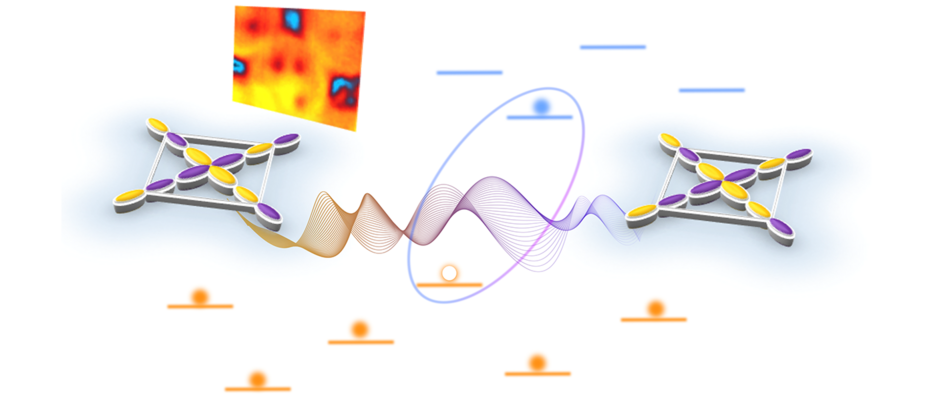Würzburg physicists have discovered that quantum entanglement toughens up quasiparticles against impurity scattering - even when they are subject to strong disorder.

Physicists at Julius-Maximilians-Universität Würzburg (JMU) have made a discovery that could boost the understanding of the role of entanglement in high-temperature copper oxide superconductors. The low-energy quasiparticles of these enigmatic quantum materials, so-called Zhang-Rice singlets, were found to be remarkably resilient against extreme disorder. This surprising resilience in an otherwise glassy electronic background is enabled by quantum entanglement - a form of quantum binding that intimately ties a hole and a spin into one effective quasiparticle and makes it harder for the particle to scatter off an impurity.
The robustness of quasiparticles
Imagine a couple walking hand-in-hand across the marketplace on a busy day: If it wanted to move from one side to the other, the crowd of people must step aside, locally dispersing the people in its surroundings and slowing down its own movement. When watched from above, the couple and their sidestepping surroundings would seemingly move as a unit. This unit is what condensed matter physicists call a quasiparticle, namely effective particles that determine the low energy excitation spectrum of a solid.
In a metal the quasiparticles typically consist of an electron surrounded by a polarization cloud of other electrons, with electron and polarization cloud moving coherently. In a real system, these quasiparticles scatter off impurities and disorder. Going back to our fictious marketplace, this means that our two lovebirds cannot just walk through an obstacle, such as a lamp post, standing in their way. Instead, they would have to walk around it, slowing down the couple's movement once again. In a real metal, this causes the electrons to scatter off impurities, impeding the electrons' movement and creating electrical resistance.
Dancing through possible obstacles
In a study now published in Physical Review Letters, the team including researchers from JMU reports that the quasiparticles in cuprate materials apparently do not abide by this scattering rule. These materials have a complex structure of copper oxide layers and are generally known for their record-breaking high-temperature superconductivity when they are doped. Their quasiparticles are Zhang-Rice singlets (ZRS), entangled composite particles where an oxygen hole teams up with a copper vacancy spin, moving through the crystal like a dancing couple.
The scientists from Würzburg tested these quasiparticles in an extremely disordered cuprate environment in which up to 40 percent of the copper atoms were replaced by lithium. The disorder is thus so immense - our "marketplace" is so full of obstacles - that it brings the normal electrons to a complete standstill. Physicists call such a system a non-ergodic glass system as particles now propagate much slower compared to the typical experimental timescales. In other words, there is no more back and forth for the visitors of our marketplace, and nothing moves anymore.
The Zhang-Rice singlets' beguiling dance of hole and spin within this quantum union - despite all odds - however, is totally unaffected by the impurities standing in their way. Their quantum entanglement prevents them from scattering, and they just move through the system - as if "the marketplace" was without obstacles.
Significance of the discovery
The study has revealed the first appearance of Zhang Rice singlets in a cuprate based electron glass and shown the emerging invulnerability of ZRS quasiparticles due to quantum entanglement. Such findings could have far-reaching implications not only for our understanding of the cuprate superconductors, but also for future technologies based on quantum coherence. In particular, the ability to stabilize quantum states with respect to external perturbations by means of quantum entanglement could play a pivotal role in the realization of quantum computing.
Parts of the work leading to the findings are the result of collaborations within ct.qmat, Complexity and Topology in Quantum Matters. The Cluster of Excellence is a joint project by JMU and TU Dresden.
Original Publication
A. Consiglio, G. Gatti, E. Martino, L. Moreschini, J. C. Johannsen, K. Prša, P. G. Freeman, D. Sheptyakov, H. M. Rønnow, R. Scopelliti, A. Magrez, L. Forró, C. Schmitt, V. Jovic, C. Jozwiak, A. Bostwick, E. Rotenberg, T. Hofmann, R. Thomale, G. Sangiovanni, D. Di Sante, M. Greiter, M. Grioni, and S. Moser: "Electron glass phase with resilient Zhang-Rice singlets in LiCu3O3" in: Physical Review Letters. 12. Februar 2024. DOI: 10.1103/PhysRevLett.132.126502






